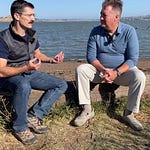Barry Goldman, founder and CSO of Pluton Biosciences introduces the concept of microbial cover crops as a new and innovative approach to improving soil health and sustainable agriculture. A plant cover crop e.g. alfalfa, is typically grown in the off-season and plowed back into the field to enrich the soil before the actual crop is planted.
Barry and his team set out to see whether some bacteria can do this, particularly around nitrogen fixation, adding ammonia to the soil from the atmosphere. He points out that since the 1950s and 1960s the world’s population has gone from roughly 3 billion people to 8 billion. Some part of that is due to the use of synthetic fertilizers - ammonia made from the Haber-Bosch process. That has fed a lot of people. But that process creates a lot of greenhouse gas as well.
Is there another way to add nitrogen to the soil that avoids undesirable side effects? When Barry and I were classmates and labmates in grad school studying Salmonella genetics, We had a saying. “If you can imagine it, a bacterium is already doing it.”
Starting with a soil sample containing about 10,000 different species, the scientists at Pluton Biosciences have identified a consortia of bacteria that will grow in the absence of carbon and nitrogen except for what they can get from the air. The consortia work together using energy from the sun to reduce CO2 into usable energy sources (photosynthesis) and fix N2 to ammonia which can be used to synthesize amino acids etc.
As an additional benefit of deploying microbial cover crops on a large scale for nitrogen fixation, it’s possible to sequester a significant amount of carbon dioxide from the atmosphere.
"If you could now take this on a hundred million acres, you removed a hundred million tons of CO2 per year... you can start tackling this and give ourselves more time to come up with even better solutions. We also believe we can put on 30 pounds of nitrogen per acre. So now, if you're on that for that much, you're essentially almost turning the amount of the Haber-Bosch process to zero. That's roughly 20 percent of the greenhouse gases that are being emitted. You put those two together, now you have a massive impact on climate change."
Not subscribed yet? Can we fix that?
Either way, I appreciate you spending time here.
What would it take the bring this potential to reality?
Of course, like anything else in life science, safety and efficacy matter. These consortia need to be tested in the field. Because they are not genetically modified, the EPA would be satisfied to know that the constituents of the consortia have been identified and are typically present wherever they are intended to be applied.
The second challenge is getting farmers to test the consortia in their own field (or a portion thereof). They will want some assurance that they would at least be compensated for any reduction in yield. And to be paid for their effort as well.
Testing in real-world fields is crucial to prove that these microbial cover crops work as expected. This involves multiple phases, from starting with a few fields to expanding once efficacy and safety are demonstrated. Amazingly, the consortia create a visible crust on the soil. Similar to what we discussed in a very early episode of this podcast, drone technology and machine vision can be used to monitor the fields and gather data on microbial cover crop performance.
Oh yeah. What’s the business model? Someone needs to pay for this. If the consortia works, the grower gets value from savings on synthetic fertilizer. There is also the carbon market. Right now that’s at $15-30 per ton of carbon sequestered per acre. Finally, does the soil improve? Does it result in better yields (more revenue)?
Barry reminds us that this is not a complete solution. But microbial cover crops have the potential to put a significant dent in greenhouse gas emissions giving us more time to develop additional remedies for climate change.
Your deepest insights are your best branding. I’d love to help you share them. Chat with me about custom content for your life science brand. Or visit my website.













